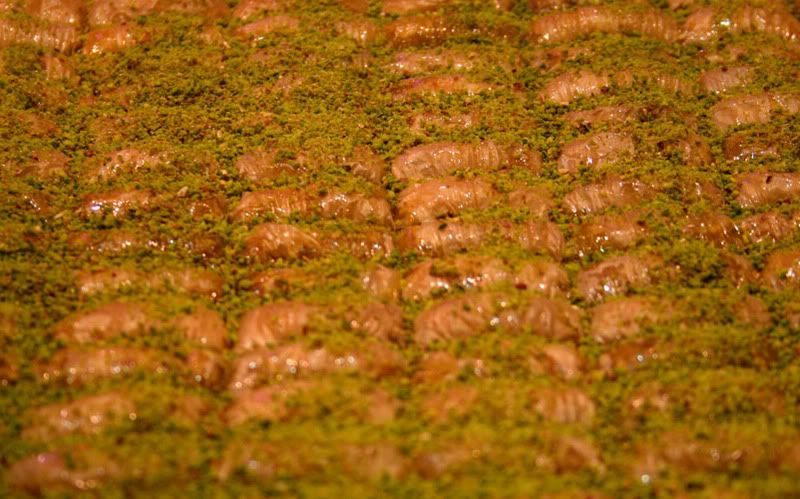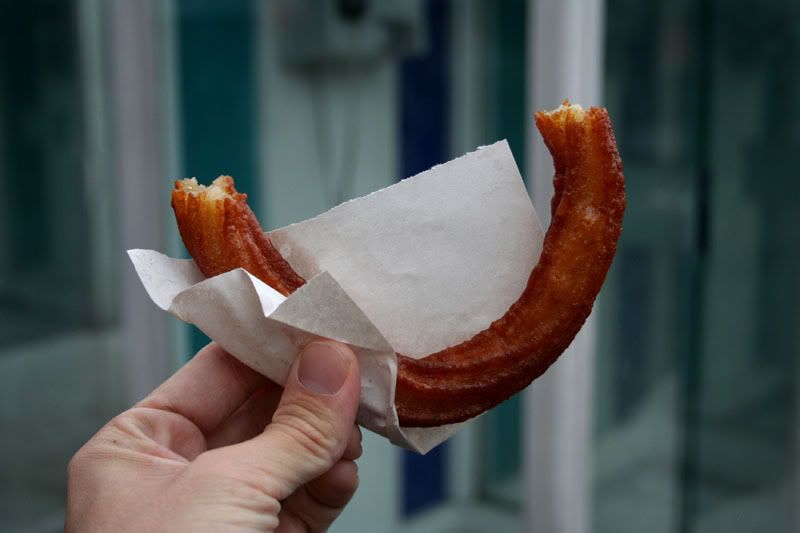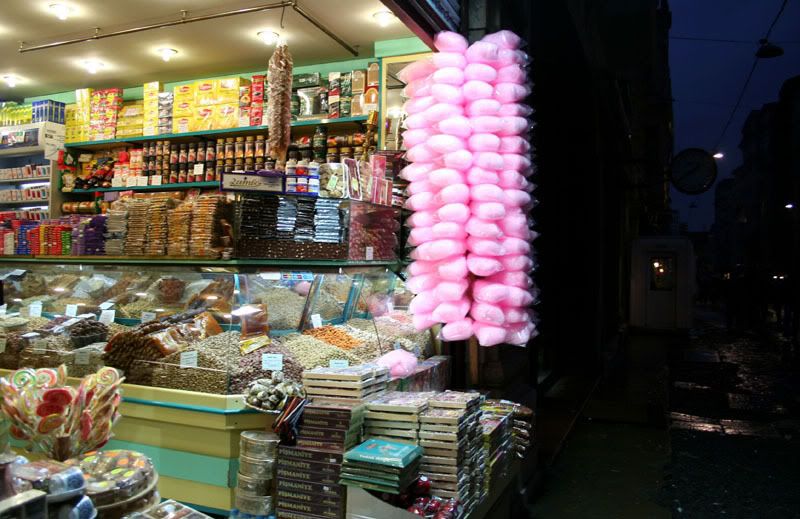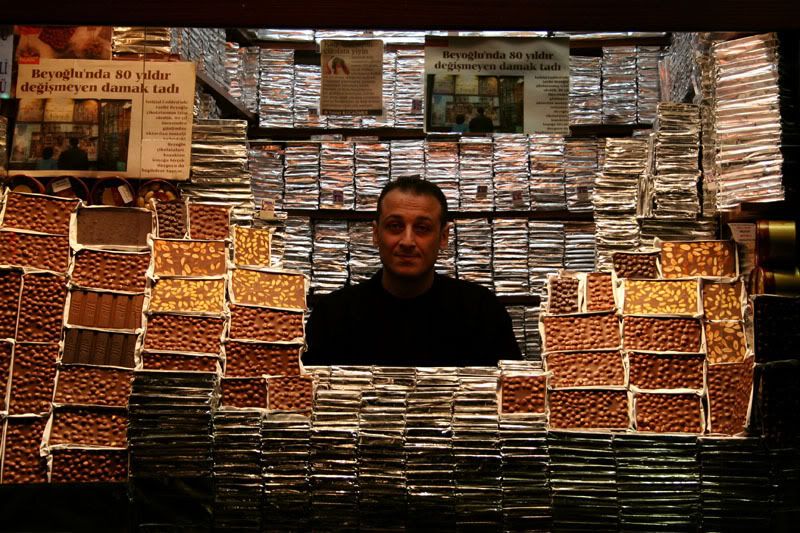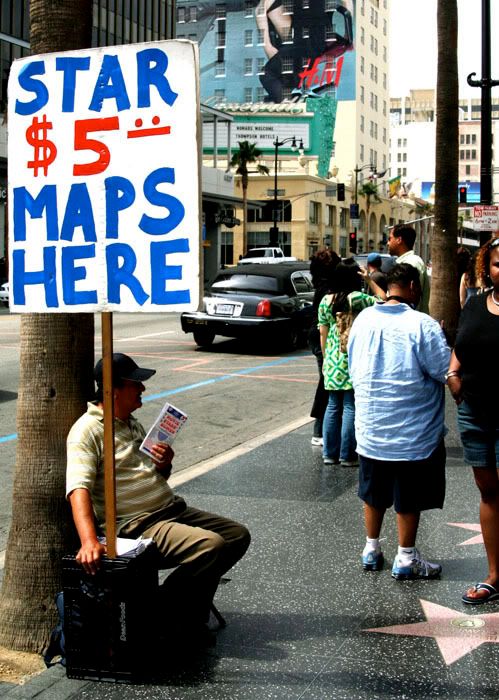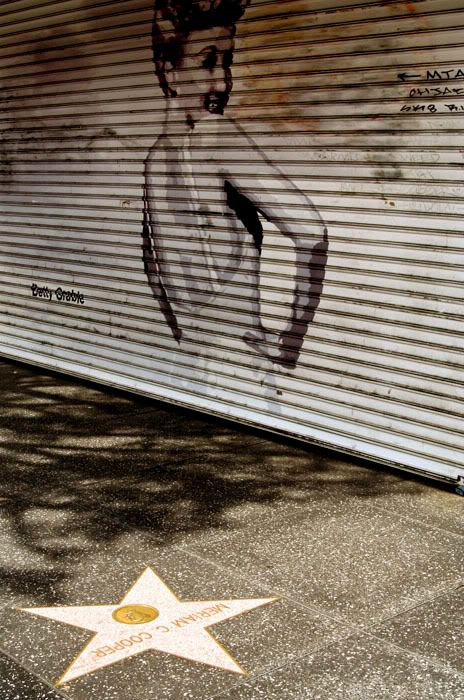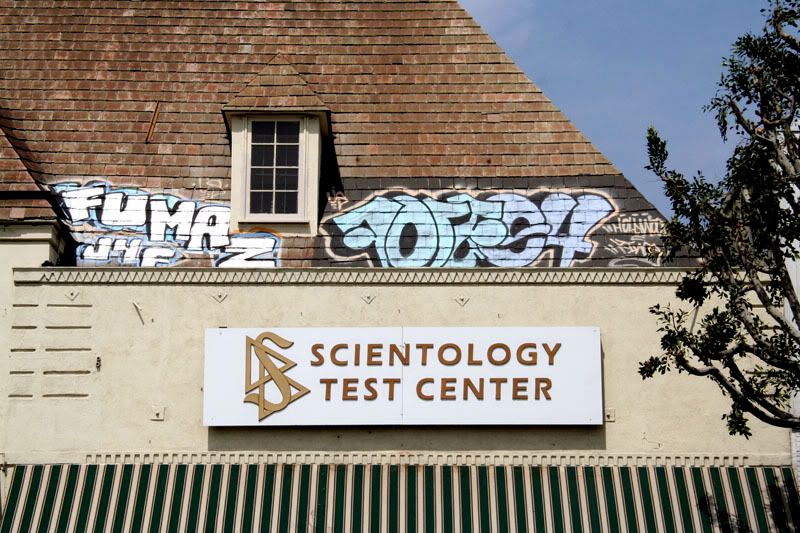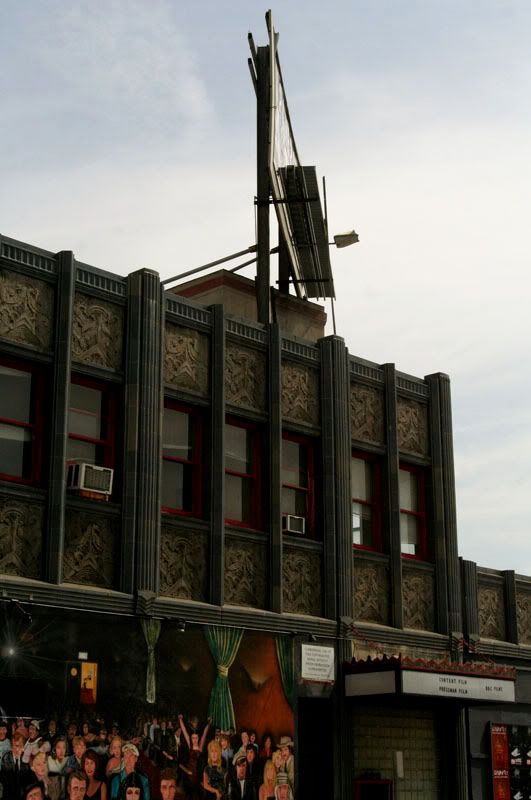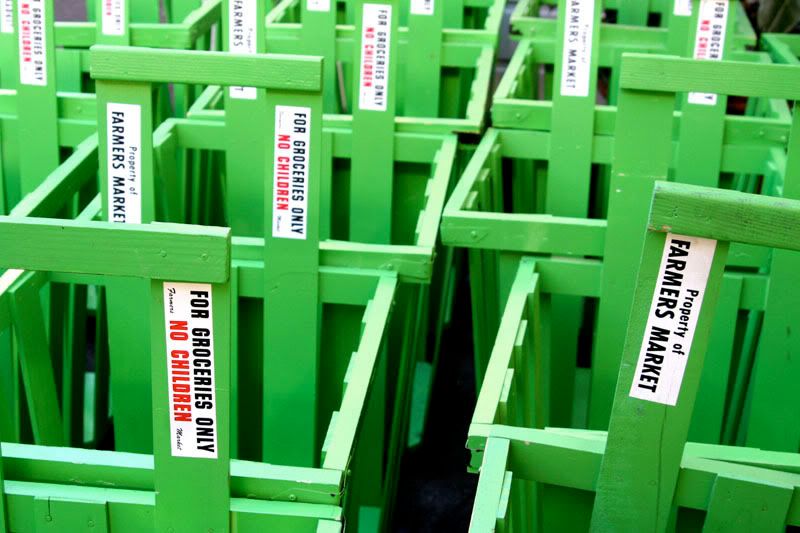
Living at the northern border of K.town has opened me up to the wonders of Midtown Los Angeles. One of the areas that I've become most fond of is the Fairfax district. The stretch of Fairfax north of Beverly holds an odd fascination, though not much real attraction. The aging kosher bakeries are reflective of the street's history as the former center of the city's Jewish community, while the faded murals and deco storefronts are suggestive of a Hollywood glory that long ago wore away on this street.
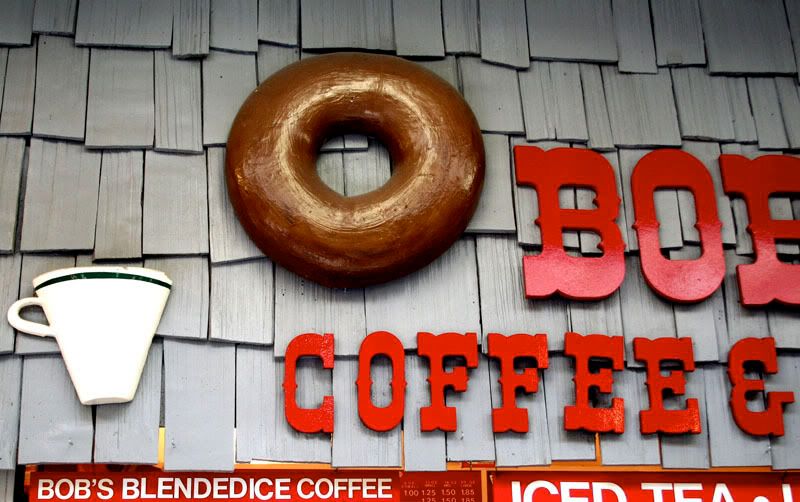
But south of Beverly, Fairfax gets interesting. While not in any way a hidden spot, I'm particularly fond of visiting the Farmer's Market. It's a good place for picking up cheap produce, and for finding meals of inconsistent quality. I've had Cajun gumbo, sugary donuts, and many cups of coffee from reluctant servers at the creperie, all prepared in a vaguely carnivalesque atmosphere of foodstands and giant plaster desserts. The Farmer's Market is of course a great spot for people viewing; the crowd is always an odd mix of B-list celebrities, shopper spillover from the Grove, and disinterested employees from the CBS lot breaking for lunch.
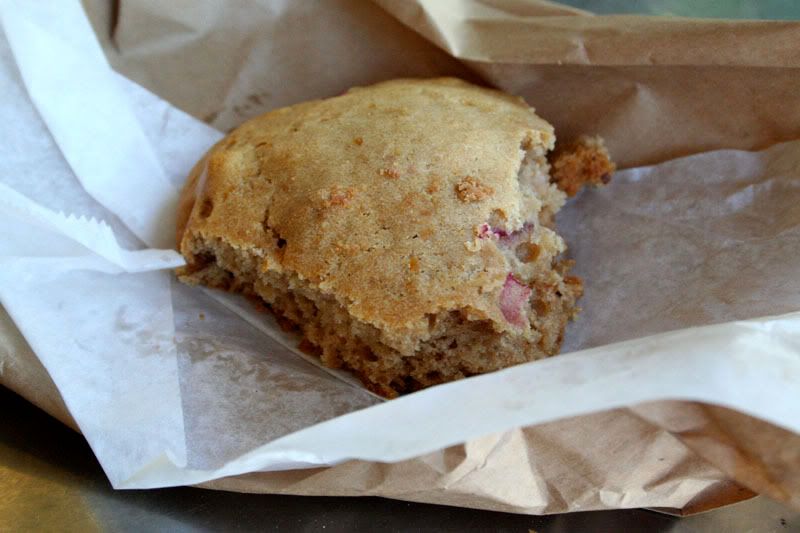
Bordeaux and I stopped for coffee at Mani's Bakery on Fairfax last week, down in the quiet residential stretch near Miracle Mile. I'd been to Mani's in Santa Monica, and though the food was good, the cafe itself was somewhat bland, with a cavernous interior reminiscent of an empty garage.
Mani's on Fairfax is the opposite extreme, a charming little coffeeshop with barely enough room for a queue to form between the bakery counter and the tables. The menu is brilliant, with six different brewed organic coffees on offer, and a wide range of sparkling, sugar-free pastries. I ordered a cup of black coffee, and Bordeaux and I selected a cranberry walnut scone to split. We grabbed a table outside, on the much less crowded sidewalk patio. We enjoyed our coffee slowly, as we read under the shade of the leafy trees. I was unsure of how the sugar-free pastries would be, but the scone's cranberries added a naturally sweet flavor that balanced perfectly with the mellow Italian roast coffee.

Just beyond LACMA, tucked between the blocks of pale yellow Colonial revival apartments, is Little Ethiopia, my favorite stretch of Fairfax. I used to catch glimpses of it on the way to LACMA on field trips with my art classes, and would always wonder what was hidden in the unassuming Afro-storefronts. I didn't actually effort to explore the neighborhood until after college, when I parked on the street, and blindly walked into the Ethiopian restaurant closest to my parking meter. The decor was quirky, a composite of African exoticism and Ethiopian nationalism in a generic restaurant setting. The food was amazing- varied in textures, flavors and spices. The meal was to be eaten by hand with injera, the strangely delicious sour-spongy bread. I've gone back to Little Ethiopia twice recently, both times to eat at
Nyala. Bordeaux, my sister Genevieve and I took my sister Olivia their for dinner when she was in town, in effort to satisfy her desire for interesting ethnic cuisine. We ordered three dishes to share: the vegetarian combo, the doro wat, and the asa tibs. Bordeaux and I each had an Ethiopian beer, selected from a drink menu that included beers from Eritrea to Namibia. The standout dish was doro wat- a peppery, mildly spicy chicken, served with a hard boiled egg (delicious, but hard to eat without utensils). We ordered three dishes, which was more than enough for the three of us, and at around $10 a person for food plus drinks, translated to what must be one of the cheapest, most delicious meals in LA.
Bordeaux and I recently went back to Nyala for lunch with a friend to try out the vegetarian buffet. While no dish was as good as the doro wot, the meal was still delicious- in particular, I liked the slightly bitter greens, and the spicy red lentils of the yemiser wot. After lunch, we had citrusy Ethiopian coffee, which was served through the smoke of a small ember of incense. The mock ceremony of the coffee was fitting of the restaurant, which reminded me a little of restaurants at tourist sites in Southern Africa- the decor caught between an effort for elegance and the desire to evoke a romanticized traditional African past.

Past LACMA, Fairfax quiets down and tapers out, running through the well-kept streets of the Carthay district. Overgrown fig-trees crack the pavement of the sidewalk, and lollipop-shaped topiaries edge manicured lawns, all set out before a glorious array of mid-twentieth century apartments. It's a quiet, subdued ending for one of the strangest, most engaging streets in Los Angeles.
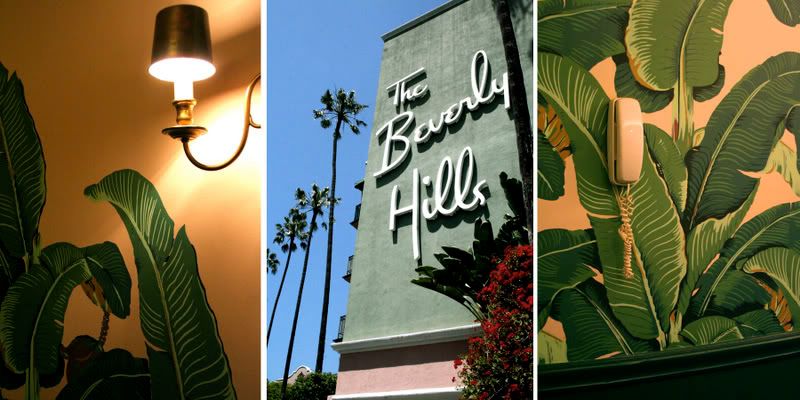 I finally had breakfast at the Beverly Hills Hotel's Fountain Coffee Room, which had been on my To-Do list since I first saw the banana-leaf lined lunch-counter in the Wallpaper* Los Angeles city guide. Perhaps uneasy about the location (Beverly Hills isn't really my town), or the exclusive atmosphere of the hotel (would there be a dresscode?), I continually delayed going until today.
I finally had breakfast at the Beverly Hills Hotel's Fountain Coffee Room, which had been on my To-Do list since I first saw the banana-leaf lined lunch-counter in the Wallpaper* Los Angeles city guide. Perhaps uneasy about the location (Beverly Hills isn't really my town), or the exclusive atmosphere of the hotel (would there be a dresscode?), I continually delayed going until today.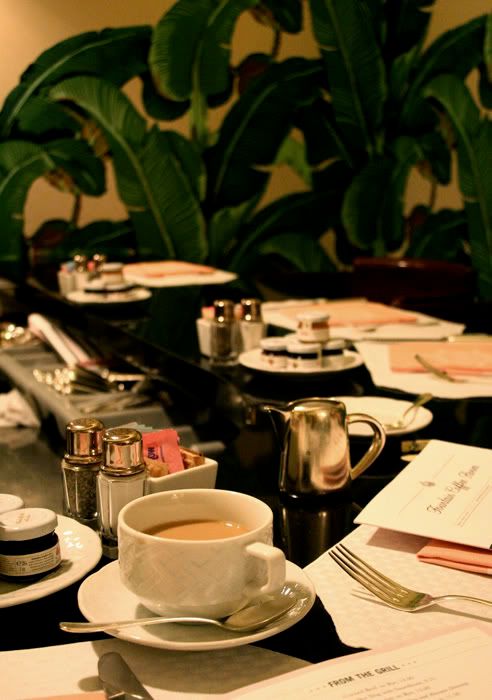 The setting of the Fountain Coffee Room, at the base of a curving stairway on the way out to the swimming pool and spa, seems almost incidental, and adds to the casual atmosphere of the room. The Fountain Room is small, truly just a long black lunch counter, lined with dark green vinyl stools. The fixtures and decor effortlessly evoke the late 1940s, when the Fountain Room opened, without seeming like either a stale museum piece or a plastic re-creation. Water and cream are served from silver pitchers, and coffee is poured into lattice-work porcelain cups, by a waitress in pink uniform and white apron. The understated fixtures are contrasted by the Fountain's signature banana-leaf wallpaper, which evokes an era when Los Angeles could still market itself as a subtropical destination.
The setting of the Fountain Coffee Room, at the base of a curving stairway on the way out to the swimming pool and spa, seems almost incidental, and adds to the casual atmosphere of the room. The Fountain Room is small, truly just a long black lunch counter, lined with dark green vinyl stools. The fixtures and decor effortlessly evoke the late 1940s, when the Fountain Room opened, without seeming like either a stale museum piece or a plastic re-creation. Water and cream are served from silver pitchers, and coffee is poured into lattice-work porcelain cups, by a waitress in pink uniform and white apron. The understated fixtures are contrasted by the Fountain's signature banana-leaf wallpaper, which evokes an era when Los Angeles could still market itself as a subtropical destination.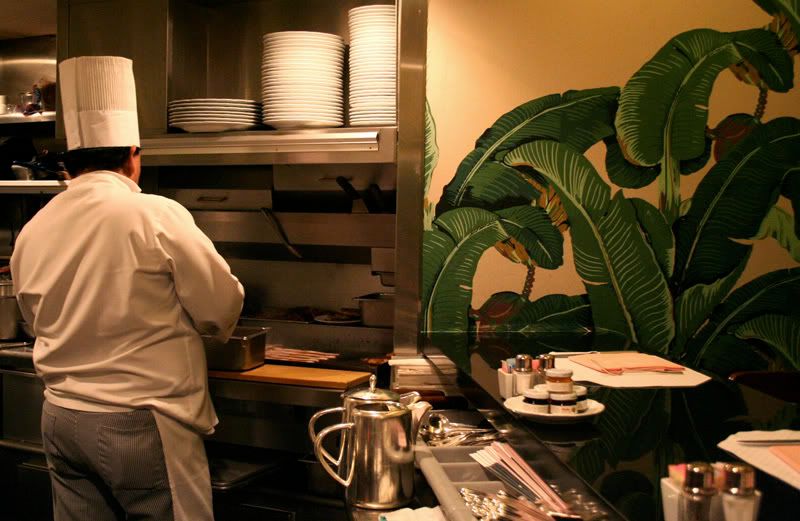 Despite its location in the Beverly Hills Hotel, the Fountain Room is a casual spot, where the waitress has time to chat with hotel guests as the chef prepares their waffles. The menu is classic diner food with a few upmarket touches, such as a caviar and sour cream omelet, and brioche french toast, served with mini jars of warm maple syrup. While a coffeeshop with the history and style of the Fountain Coffee Room could easily choose to rest on its reputation, the Fountain continues to offer an impressive, well-prepared menu. So many old Hollywood spots have either been torn down (Schwab's Pharmacy), or been allowed to age gracelessly (Canter's) that it's nice to see one that still retains an aura of understated glamor.
Despite its location in the Beverly Hills Hotel, the Fountain Room is a casual spot, where the waitress has time to chat with hotel guests as the chef prepares their waffles. The menu is classic diner food with a few upmarket touches, such as a caviar and sour cream omelet, and brioche french toast, served with mini jars of warm maple syrup. While a coffeeshop with the history and style of the Fountain Coffee Room could easily choose to rest on its reputation, the Fountain continues to offer an impressive, well-prepared menu. So many old Hollywood spots have either been torn down (Schwab's Pharmacy), or been allowed to age gracelessly (Canter's) that it's nice to see one that still retains an aura of understated glamor.

